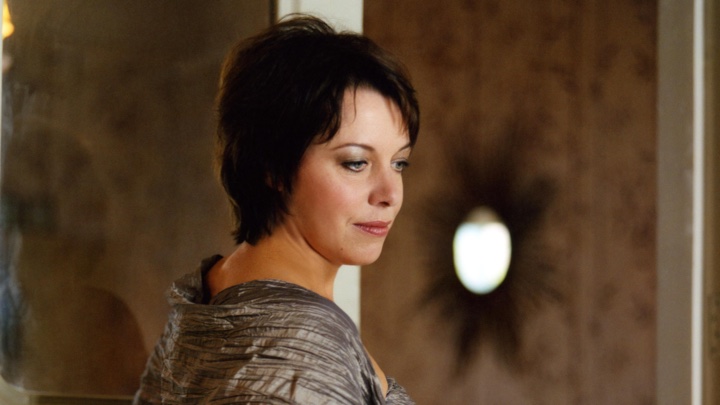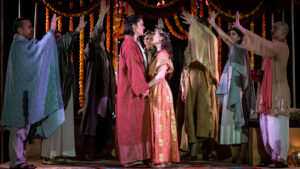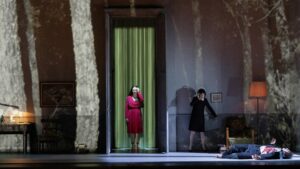
These artistic qualities were manifest in a largely excellent recital of late Romantic art songs that the soprano and pianist Magnus Svensson presented at UC Berkeley’s Zellerbach Hall this past Sunday.
Stemme’s program guided her audience through a period of musical history that explores themes of love and mortality with texts that traverse emotional extremes. Despite her chosen pieces’ more modest dimensions, these bold song collections by Wagner, Sigurd von Koch, Mahler, and Kurt Weill complement Stemme’s heroic timbre and her keen sense for verbal inflection.
Given Stemme’s extensive association with Wagner’s oeuvre, it comes as no surprise that she would choose to open her recital with the ambitious Wesendonck Lieder. Wagner’s miniatures, written with the sinuous motifs of Tristan und Isolde in mind, evoke the longing, intoxicating desire, and fatality present within his most revolutionary score. Here, Stemme’s decades of plumbing Isolde’s text allow her to foreground the colors, contrasts and nuances contained in Wagner’s poetry.
In the more intimate “Der Engel,” “Im Treibhaus,” and “Träume,” Stemme captured the scores’ hypnotic and evocative qualities by progressively deploying flecks of intriguing color and verbal nuances. When tackling more exultant pieces like “Stehe still!” and “Schmerzen,” Stemme employed the same verbal detailing and her formidable, heroic timbre to build towards the rapturous climaxes.
Despite Magnus Svensson‘s unyielding and rigid accompaniment, which failed to capture these songs’ legato and rich orchestral underpinnings, Stemme’s deep connection with Wagner’s music allowed her to transcend these limitations and convey his amorous poetry to the audience. T
he composer’s song cycle was followed by Liszt’s instrumental transcription of Walter’s “Am Stillen Herd” from Die Meistersinger von Nürnberg, which Svensson rendered in a rather dry and unremarkable fashion. While Svensson’s interpretation of the phrases describing Walter’s introduction to the guild masters was stiff and unconvincing, he later managed to capture the fluidity and sweeping grandeur of Liszt’s transcriptions as the aria built towards its climactic conclusion.
Stemme and Svensson concluded the first half of their program with a rarity from the Swedish composer Sigurd von Koch, “Die geheimnisevolle Flöte.” Koch’s cycle is structurally and expressively rooted in the German Romantic song tradition, and draws from the same Tang Dynasty poetry collection by Hans Bethge that inspired Mahler’s monumental “Das Lied von der Erde.”
From an aural perspective, Koch’s music echoes the profound sense of Weltschmerz that pervades much of Mahler’s song literature, yet employs a brighter and more Straussian harmonic palette to evoke the vivid expression of Bethge’s poetry. Stemme’s variegated word painting and control over the dynamics of her dramatic singing enabled her to showcase the glowing romance of Koch’s writing, as evidenced by her exceptional renditions of “Traurig Frühlingsnacht” and “Herbstgefühl.”
Mahler’s Kindertotenlieder is a cornerstone of the lieder repertory that is often performed by either a baritone or mezzo soprano soloist with an orchestral accompaniment. Stemme’s soprano, which has darkened considerably in recent years, now appears poised to inhabit the heavier and more tragic undertones of material that recounts a grieving parent’s reaction to their childrens’ death.
Her weighty readings of “Nun will die Sonn’ so hell aufgeh’n” and “Oft denk’ ich, sie sind nur ausgegangen” emerged with a searing intensity one often experiences from her more searching stage assumptions of Wagner’s heroines. The other three songs in the cycle did not emerge with the same emotional immediavvcy–caused in part by Svensson’s unvaried instrumental accompaniment and Stemme’s constant referencing of the score.
During the final quarter of her recital, Stemme enraptured the audience with a performance that was the pinnacle of the afternoon’s offerings. Her animated and theatrical renditions of Brechtian texts set to the music of Kurt Weill displayed her remarkable artistic range, recalling the searing intensity that has come to define her assumptions of Elektra.
Stemme imbued “Surabaya Johnny” and “Nanna’s Lied” with a sardonic bite, while her rendition of the French song “Youkali” radiated with a lyrical, evocative glow. Her lovely encore of “My Ship” from Lady in the Dark was a fitting conclusion to this survey of the Austro-German lied.
In contrast to the pensive Romantic literature of the preceding cycles, these Weill pieces allowed Stemme to showcase her prowess as a v, captivating the audience with her magnetic presence. Stemme’s extraordinary performance in these Weill pieces may inspire her to consider taking on the character of Mahagonny‘s Leokadja Begbick, another fascinating dramatic role to crown her illustrious career in opera.
Ms. Stemme’s recital served as a reminder of what an experienced artist can deliver to her audiences through years of distilling the art of pairing text to music. This is perhaps most evident in her interpretation of the Wesendonck Lieder, which she has recorded repeatedly over two decades.
If the lyricism and youthful bloom heard on her initial forays have yielded to time, the textual insight that she unearths in recent performances demonstrates the evolving intellectual depth that have made her a cherished artist. Finally, her excursions into less familiar territory like the Weill and Mahler suggest the possibilities that remain in an interpreter of her caliber.
Photo © Warner Classics





Comments